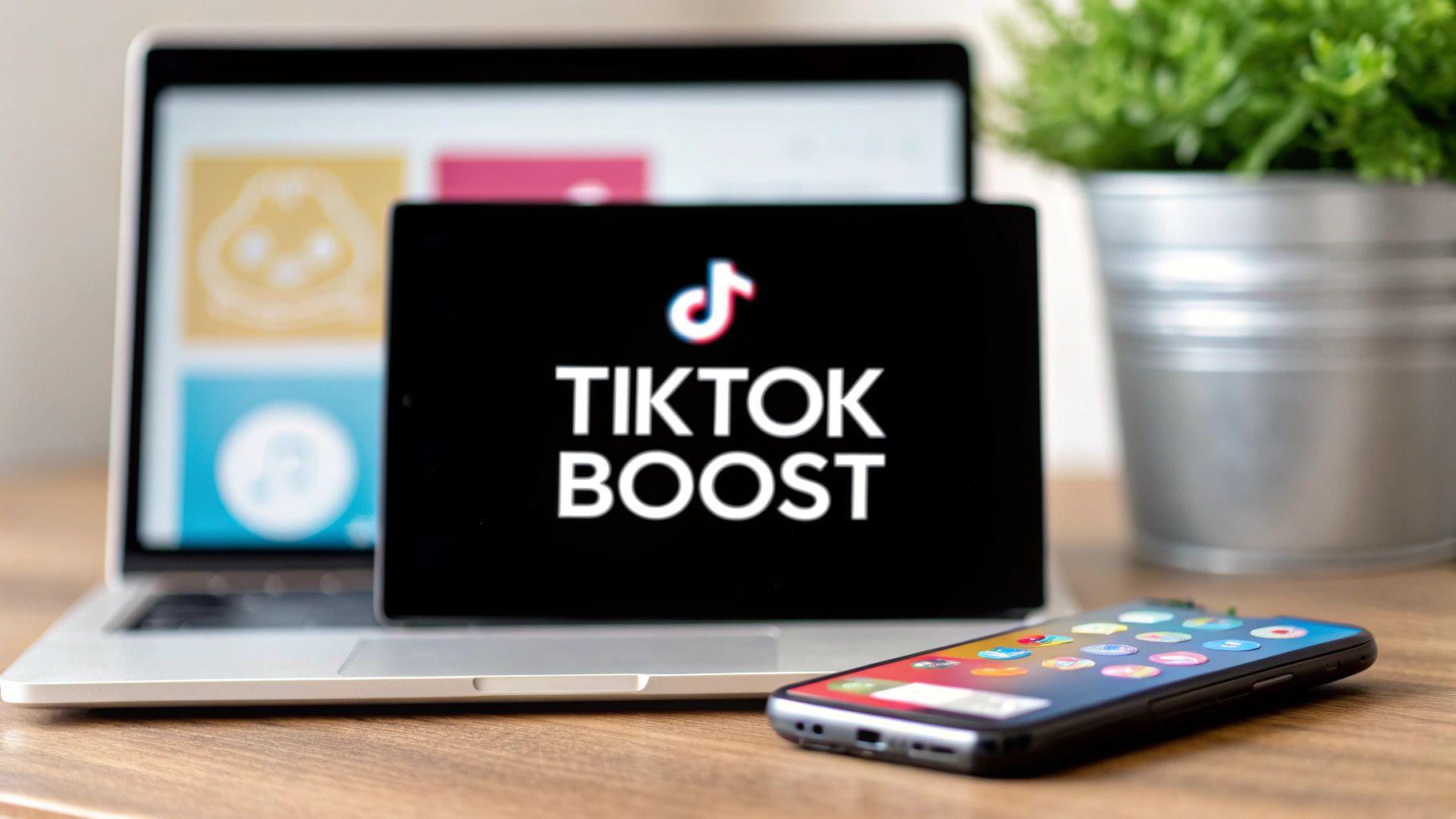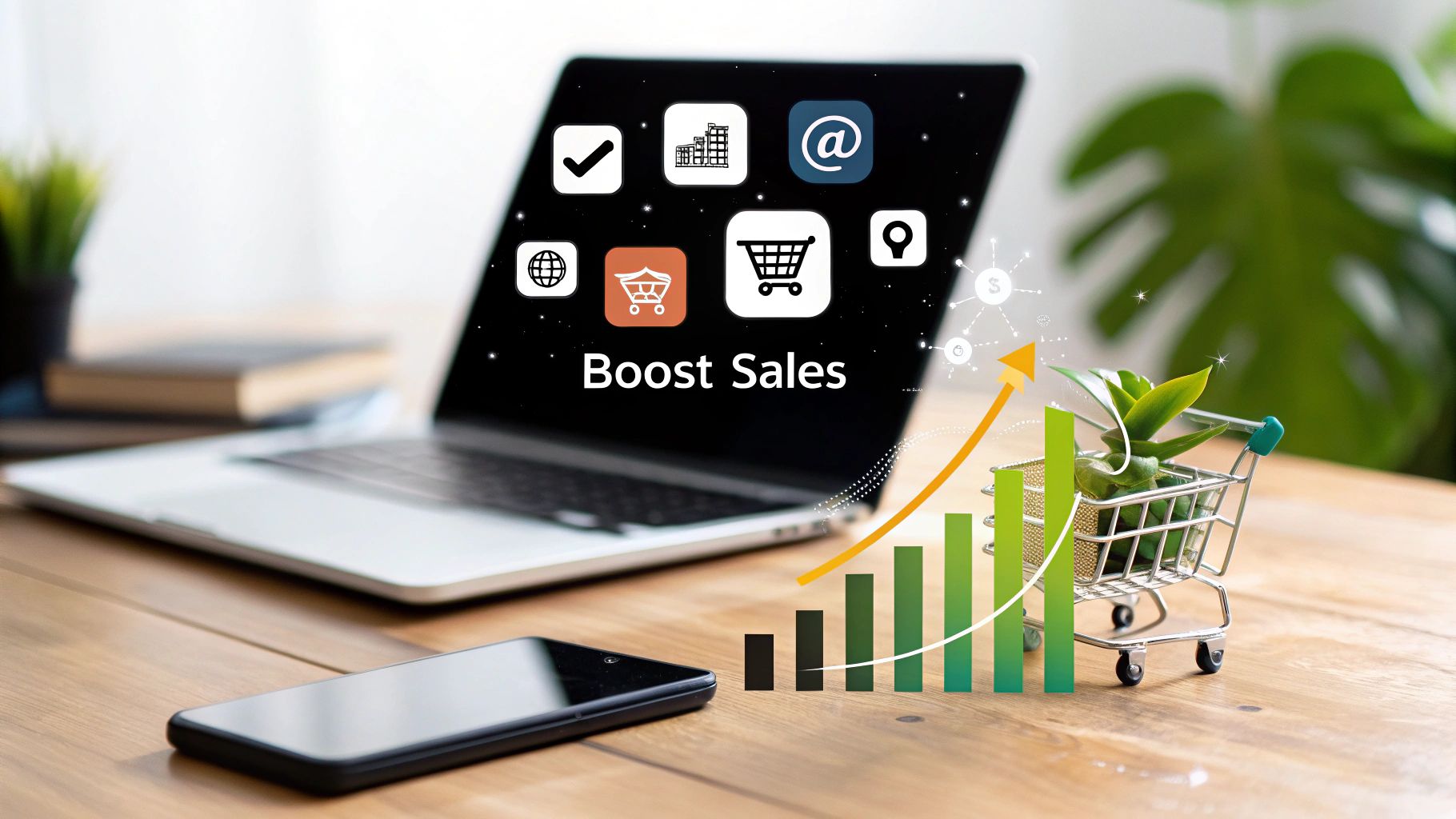Shoppable Content: Turn Social Posts Into Sales (2025)
April 7, 2025
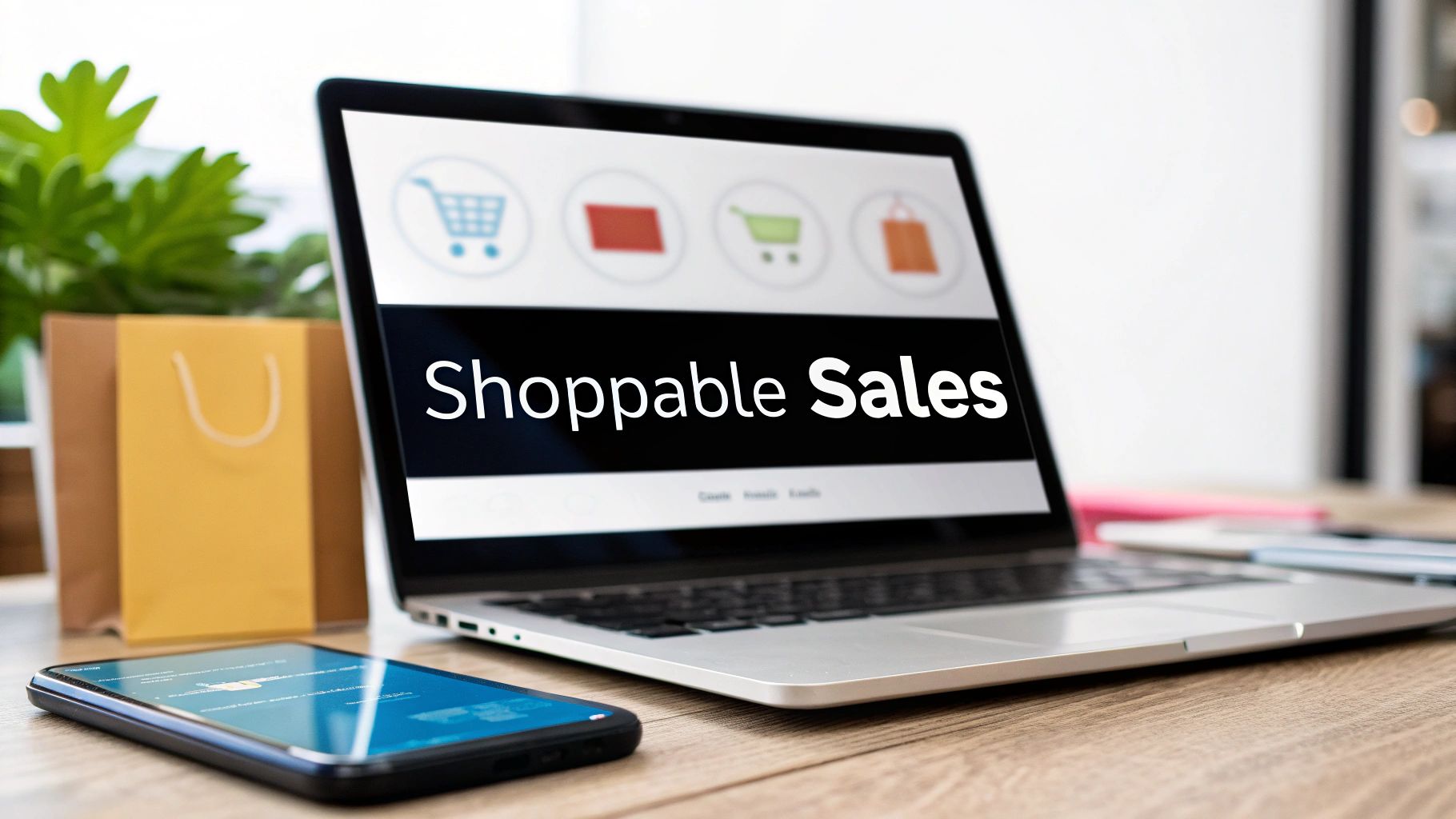
The Evolution of Shoppable Content: Why It Matters Now
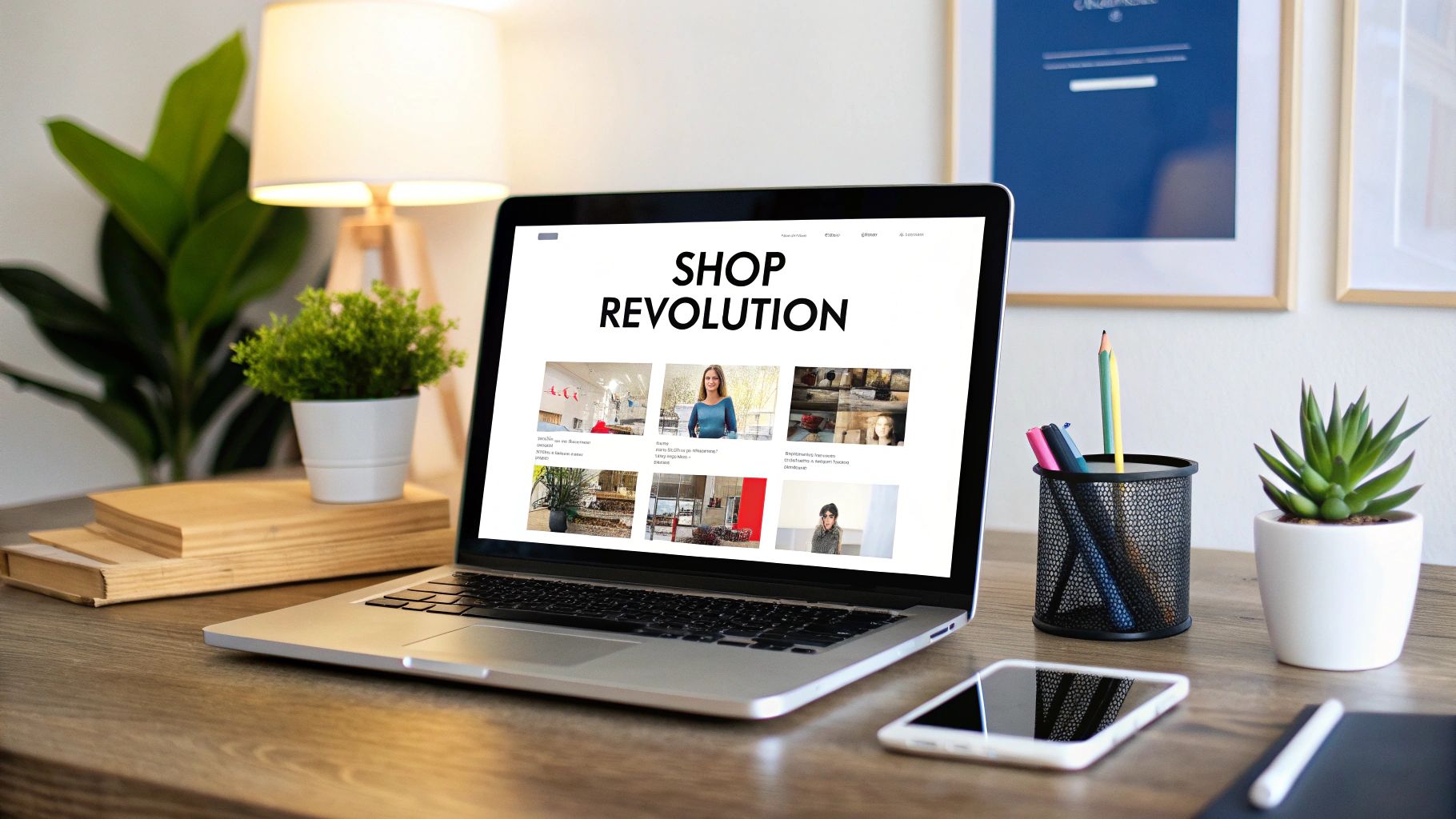
The way consumers shop has changed drastically. The journey from discovering a product to buying it is much shorter now, largely thanks to shoppable content. This method turns passive browsing into active purchasing. Instead of just looking, consumers can buy products directly within the content they're enjoying.
From Novelty to Necessity: The Changing Consumer Landscape
Shoppable content was initially seen as a trendy marketing tactic, something interesting for brands to experiment with. The growth of e-commerce and social media, however, has changed things. Consumers now want a smooth, easy shopping experience. They want to buy what they see immediately, without clicking through numerous websites or apps. This shift in consumer behavior makes shoppable content essential for businesses.
For example, picture yourself seeing a fashionable outfit on your favorite influencer's Instagram feed. With shoppable content, you can buy every piece of that outfit directly from the post, without ever leaving the app. This eliminates the extra steps and meets the immediate needs of today's consumer. Plus, the rise of shoppable content has altered how businesses use social media for sales. In recent years, 68% of global consumers clicked on shoppable social media posts. This shows how effective this method is for connecting with audiences and driving sales directly from social media. For more statistics, check out the Tagshop Blog – Shoppable Instagram & UGC.
The Power of Instant Gratification: Why Shoppable Content Works
Shoppable content succeeds because it taps into the human desire for instant gratification. By shortening the time between discovering and buying something, brands satisfy that immediate need. This is particularly effective for impulse buys, where an easy checkout process can greatly improve sales. Imagine a "buy now" button on everything a consumer sees online – social media posts, video tutorials, or blog articles.
This instant buying option creates a sense of urgency, encouraging shoppers to buy quickly before an item sells out. This works especially well for limited-time offers or exclusive product releases. Shoppable content also provides useful data and insights into consumer behavior. By tracking which products are bought directly through content, brands can better understand what their target audience likes and improve their strategies. This constant feedback leads to more targeted and successful marketing campaigns.
High-Converting Shoppable Content Formats Across Platforms
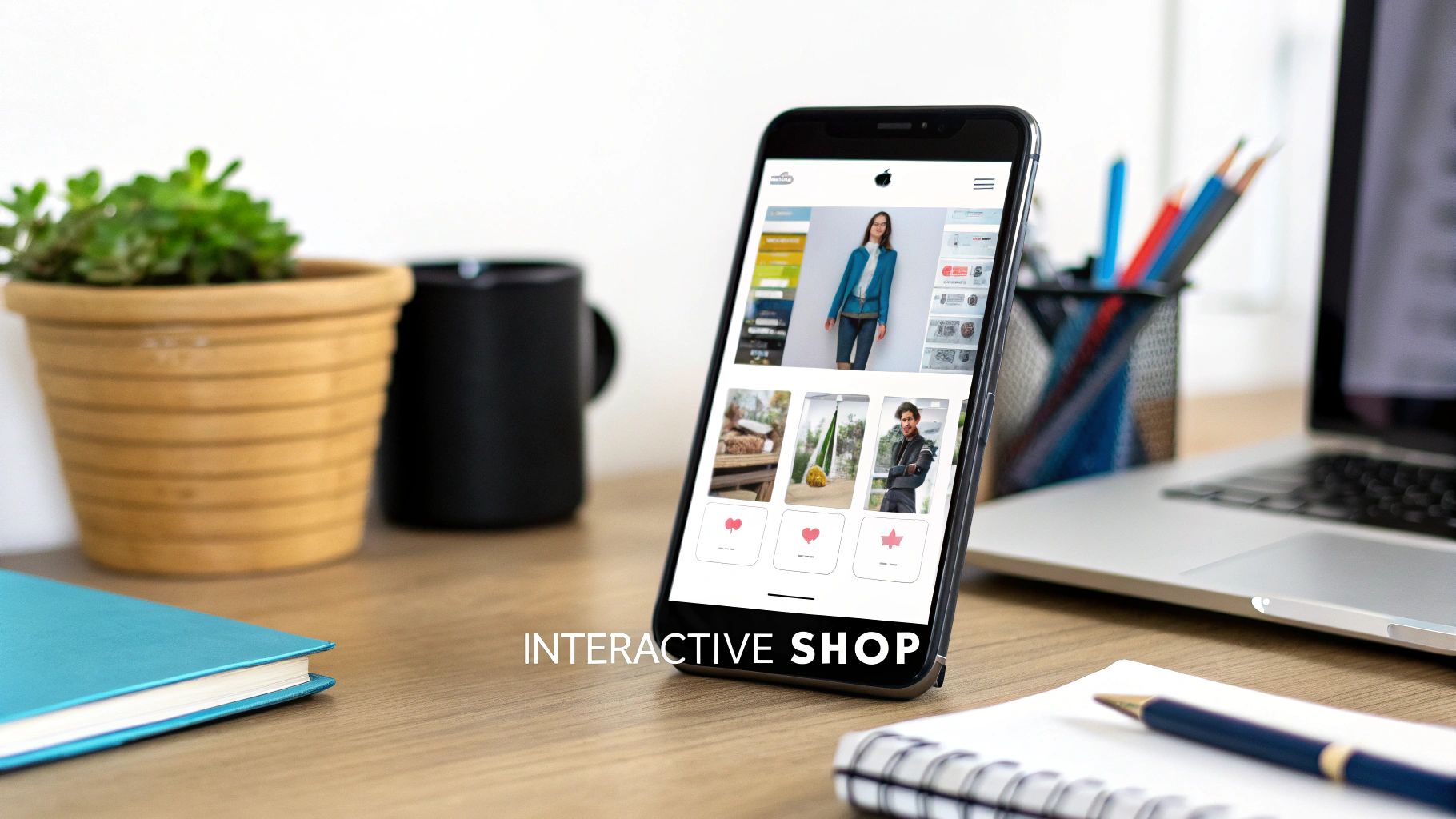
Shoppable content has come a long way. It's no longer just about tagging products. Businesses now have many different formats to choose from. Each one offers unique ways to turn engagement into sales. Picking the right format is key to maximizing conversions across different platforms. Let's explore some of the most effective shoppable content formats and how they perform.
Shoppable Social Media Posts: Instant Gratification
Social media platforms like Instagram, TikTok, and Pinterest have built-in shoppable features. This lets brands tag products in posts, stories, and even live streams. For example, Instagram Shopping Tags let users buy products directly from a post. They don't even have to leave the app. TikTok's live shopping feature lets viewers add products to their carts while watching. This creates a sense of urgency. You might be interested in: How to master selling on Instagram with Shopify.
- Instagram Shopping Tags: Great for showcasing products in real-life settings. Users can shop entire looks.
- TikTok Shop: Perfect for live product demos and talking with potential buyers in real-time.
- Pinterest Product Pins: Effective for reaching people already searching for and saving products.
Shoppable Images and Videos: Engaging Storytelling
Shoppable images and videos are more than static displays. They use interactive elements. Brands tag products within the content to create immersive shopping experiences. A fashion brand, for example, could make a shoppable video of their new collection. Viewers can click on items to learn more and buy them right from the video.
- Shoppable Images: Product photos become interactive catalogs. Individual items are tagged within the image.
- Shoppable Videos: Engage viewers with demos and tutorials. They can buy featured items instantly.
Shoppable Articles and Blog Posts: Educating and Converting
Blog posts and articles educate consumers about products. They also offer a direct path to purchase. By adding shoppable elements, brands can turn readers into buyers. A beauty brand, for instance, could write about skincare routines and include links to the recommended products.
- Embedded Product Links: Direct links to product pages from the article make buying easy.
- Shoppable Diagrams and Graphics: Interactive visuals show off product features. Educational content becomes a sales opportunity.
Shoppable Livestreams and Ads: Driving Real-Time Sales
Livestream shopping and shoppable ads create a feeling of "buy now." They encourage impulse purchases. These formats are great for driving real-time sales. A brand could host a live shopping event on social media with special deals and product demos.
- Livestream Shopping: Engage viewers with live demos, Q&A sessions, and limited-time offers.
- Shoppable Ads: Ads become direct purchase opportunities. The path to conversion is streamlined.
Choosing the Right Format for Your Brand
The best shoppable content format depends on a few things. These include your target audience, product type, and overall marketing plan. Trying different formats across various platforms helps you find what works best. By carefully choosing and improving shoppable content, brands create engaging shopping experiences. This drives conversions and builds brand loyalty. Here’s a table to help you plan your strategy:
To help you select the right format, consider this table:
Shoppable Content Formats by Platform
This table compares the most effective shoppable content formats across major platforms, highlighting unique features and considerations for each combination.
| Platform | Best Content Formats | Key Features | Audience Engagement |
|---|---|---|---|
| Shoppable Posts, Stories, Reels | Product tagging, lifestyle imagery | High, visually driven | |
| TikTok | Shoppable Livestreams, In-Feed Videos | Real-time interaction, influencer marketing | High, trend-focused |
| Shoppable Product Pins | Visual discovery, saved items | High, purchase-oriented | |
| Website/Blog | Shoppable Images, Videos, Articles | Embedded product links, detailed information | Medium, information seeking |
| Shoppable Posts, Ads | Targeted advertising, social sharing | Medium, diverse audience |
By using these different shoppable content formats, you can turn your online presence into a real sales driver. Track your results and keep improving your approach for maximum impact.
Crafting Shoppable Content That Doesn't Feel Like Selling
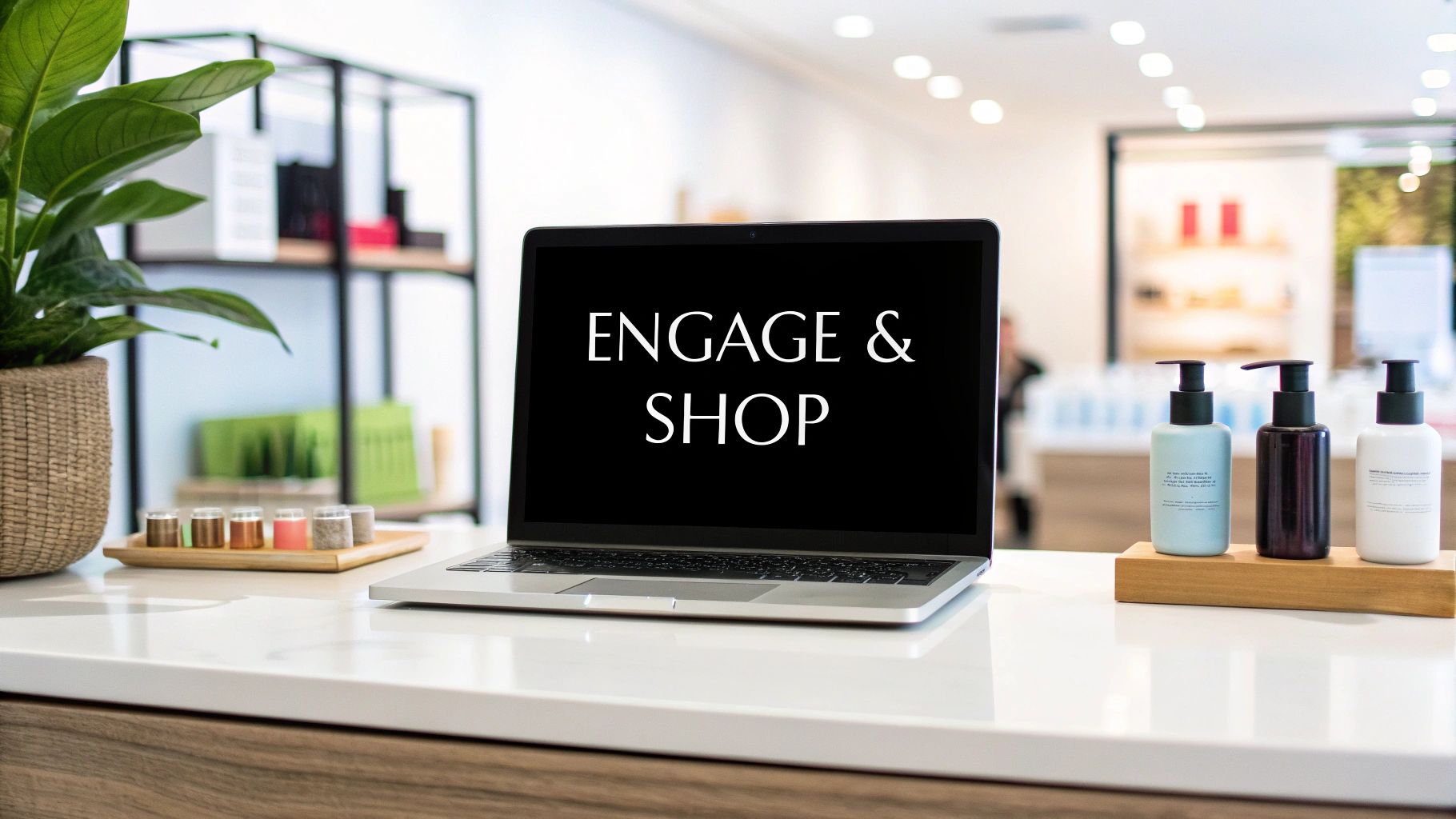
The magic of shoppable content lies in its ability to seamlessly blend valuable information with purchasing opportunities. It's about creating content that truly resonates with your audience first, with the shopping element integrated naturally. This approach respects the viewer's experience and avoids aggressive sales tactics that can discourage potential customers.
Finding the Balance: Content First, Commerce Second
The most effective shoppable content prioritizes providing real value. Think of it this way: you're offering helpful advice or entertaining stories, and the products featured are simply tools that enhance that experience. This subtle approach feels less like a sales pitch and more like a genuine recommendation.
For example, a fitness influencer might share a workout routine, tagging the apparel and equipment they use. The focus is on the workout itself, not just pushing products.
Many platforms use influencers to create shoppable content. If you’re looking to incorporate influencer marketing into your strategy, Ecommerce Influencers is a helpful resource. Features like Instagram’s shoppable posts and Reels allow seamless product tagging, making purchasing even easier. This ease of purchase further amplifies the success of shoppable content. Learn more about shoppable posts and social commerce.
Subtle Strategies for Seamless Integration
Several techniques can enhance the effectiveness of shoppable content without making it feel overly promotional. These subtle adjustments can have a big impact on conversion rates:
- Natural Product Placement: Showcase products within the context of a story or tutorial, letting them appear organically.
- Compelling Visuals: High-quality images and videos grab attention and make products more desirable.
- Clear Calls to Action: Use concise and inviting language for your calls to action, such as "Shop the Look" or "Get the Recipe."
- Authenticity and Transparency: Maintain a genuine voice and be transparent about any sponsored content or affiliate relationships.
Building Trust and Driving Conversions
By prioritizing authenticity and providing value, brands can build trust with their audience. This trust is key for driving conversions and creating loyal customers. When consumers feel respected and informed, they’re more likely to make purchases they feel confident about.
This approach shifts from transactional interactions to building meaningful relationships. This, in turn, creates a positive feedback loop where engaged customers become brand advocates, extending the reach and impact of shoppable content.
Measuring What Actually Matters in Shoppable Content
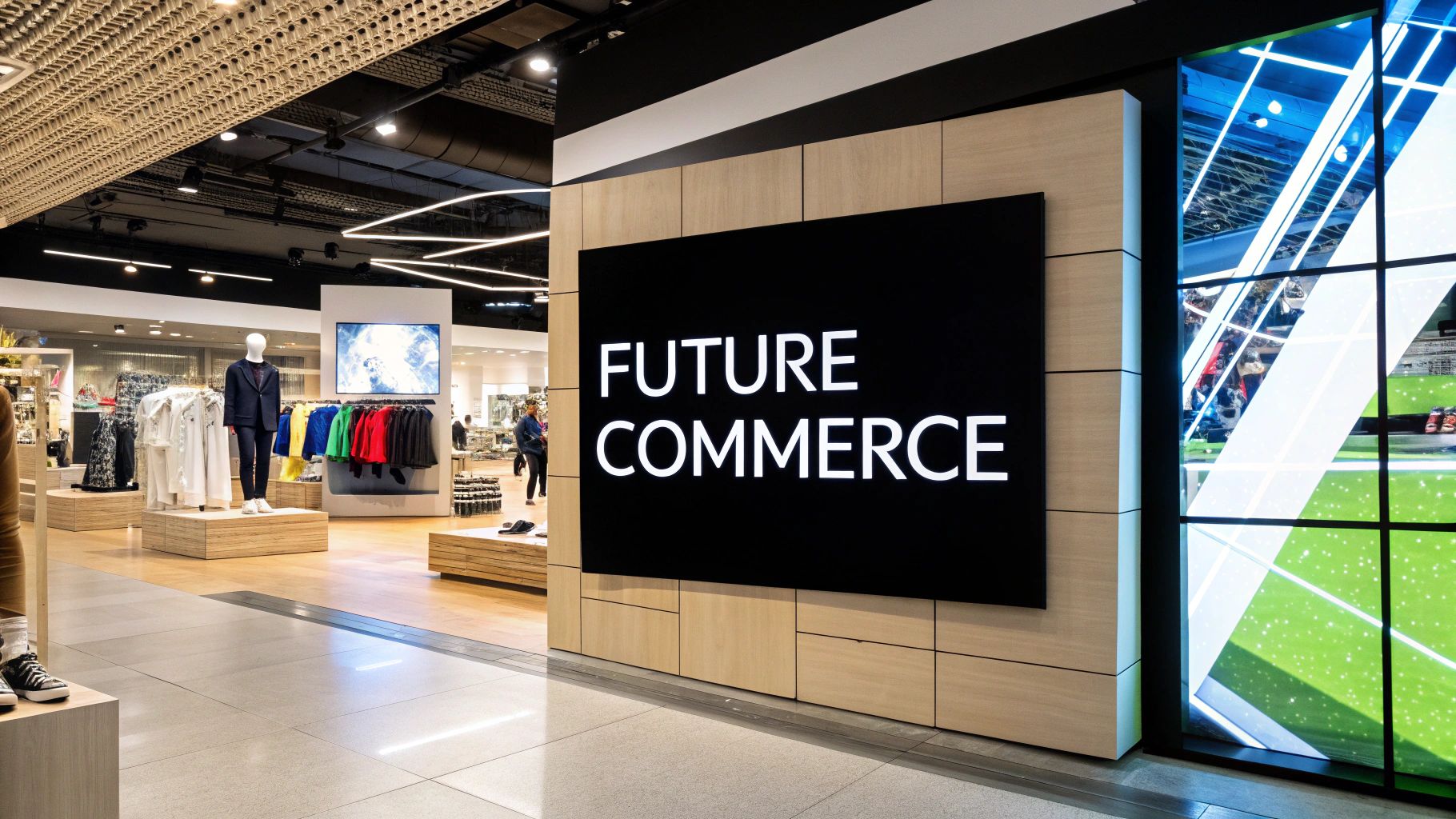
Clicks and sales are important metrics for any online business. However, they don't tell the whole story when it comes to shoppable content. Savvy brands understand that a more in-depth measurement framework is needed. They analyze engagement, map the customer journey, and utilize proper attribution models to understand content effectiveness.
Beyond the Basics: Key Engagement Signals
Engagement is more than just likes and shares. It's about understanding which actions demonstrate real buying intent. Dwell time on shoppable elements, product page views stemming from content, and add-to-cart rates are all crucial indicators. These metrics signal a higher probability of a purchase.
Also valuable are metrics like saved content and return visits. These actions show a sustained interest in both the products and the brand, highlighting the potential for future sales. This data is invaluable for refining targeting and personalizing the shopping experience.
Mapping the Customer Journey: From Discovery to Purchase
Tracking the customer journey from start to finish is essential. This involves understanding how customers interact with your shoppable content at different touchpoints. It helps answer key questions: Where did they discover your content? Which actions did they take leading up to the purchase?
For example, a customer might discover a shoppable post on Instagram. Later, they might visit the brand's website. Finally, they might complete their purchase a few days later after clicking on a retargeted ad. Understanding this journey unveils what influences buying behavior.
This process helps identify and eliminate friction points. By optimizing these areas, brands can smooth the path to purchase, which ultimately boosts conversions. For more on increasing online sales, check out this article on how to increase sales on Shopify.
Attribution Models: Giving Credit Where It’s Due
The right attribution model is essential for accurate measurement. Different models assign credit for conversions in different ways. A last-click attribution model gives all the credit to the final interaction. This overlooks the impact of earlier touchpoints, such as that initial shoppable Instagram post.
Multi-touch attribution models offer a more balanced view. They distribute credit across all touchpoints in the customer journey. This reveals how each piece of shoppable content contributes to the final conversion, allowing for more effective strategy optimization.
Continuous Testing and Improvement
Shoppable content measurement isn't a one-time activity. It requires ongoing testing and improvement. Set clear benchmarks and use A/B testing to experiment with different formats, calls to action, and placement strategies. This iterative process uses performance data to refine your approach and create more engaging, higher-converting shoppable content.
The following table summarizes key metrics for gauging the success of your shoppable content strategy.
Key Metrics for Shoppable Content Success
This table outlines the most important metrics to track when evaluating shoppable content performance, explaining what each measures and how to interpret results.
| Metric | What It Measures | Benchmark Range | Optimization Tactics |
|---|---|---|---|
| Dwell Time | Time spent interacting with shoppable elements | Industry average varies | Interactive elements, compelling visuals |
| Product Page Views | Clicks from shoppable content to product pages | Aim for higher than average | Clear calls to action, enticing product previews |
| Add-to-Cart Rate | Percentage of users adding products to cart from shoppable content | 2-5% is a good starting point | Streamlined add-to-cart process, promotions |
| Saved Content | Number of users saving shoppable content for later | Track growth over time | High-quality content, easy save options |
| Return Visits | Number of users returning to engage with shoppable content | Aim for increasing return rate | Personalized content, retargeting campaigns |
By focusing on these metrics, brands can gain a clearer understanding of what resonates with their audience and optimize their shoppable content strategy for maximum impact.
The Future of Shoppable Content: Beyond the Basics
Shoppable content isn't some far-off dream anymore; it's quickly becoming the here and now of online retail. While many brands are just starting to use basic shoppable features, innovative companies are pushing the limits of what's possible with next-generation shoppable experiences. This shift is happening because consumers are changing and want a smooth, integrated shopping experience.
Emerging Trends: From AR to AI
The next big thing in shoppable content will be defined by technologies like augmented reality (AR) and artificial intelligence (AI). Imagine trying on clothes virtually at home using AR or getting personalized product recommendations powered by AI. These advances go beyond simple product tags and create dynamic, interactive shopping experiences.
This means the line between browsing and buying will become even fuzzier, which presents exciting opportunities for brands and consumers alike.
For example, AR try-on technology lets customers see how furniture would look in their living room or how makeup would look on their face before they buy. This interactivity bridges the gap between shopping online and in person, boosting consumer confidence and influencing purchasing decisions.
AI-powered personalization engines also play a role. They can analyze user data to predict what a customer might buy, offering tailored product suggestions and creating a more relevant shopping experience.
Social Commerce and the Expanding Market
The future of shoppable content is tied to the growth of social commerce. This blend of social media and e-commerce is changing how brands connect with their customers. This emerging market has huge growth potential, projected to hit $82.4 trillion by 2030. Learn more about social commerce statistics and growth projections. This shows a major shift in consumer behavior, highlighting the need for businesses to adapt and embrace shoppable content strategies.
Building a Flexible Future
Smart brands are already preparing for these changes. They know that flexibility is essential in today’s constantly changing online world. They're building content ecosystems that can adapt to new technologies. This proactive approach involves creating modular frameworks that easily integrate with future innovations.
This means brands aren't just adding single shoppable features; they're building strong, future-proof systems. This adaptability will be key to staying competitive and getting the most out of shoppable content in the years to come. By embracing these changes, brands can stay ahead of the game and give their customers cutting-edge shopping experiences that fit seamlessly into their lives online.
Shoppable Content Success Stories: What Actually Worked
Success with shoppable content isn't a matter of chance. It's all about a well-defined strategy. Let's delve into some real-world examples of what works and how these tactics can be applied to your own business.
Glossier: Seamless Social Media Integration
Glossier, the popular beauty brand, truly understands how to make shoppable content feel organic on Instagram. Their strategy blends shoppable product announcements with user-generated content and visually appealing product photography. This creates a smooth shopping experience directly within the social media feed. It's a prime example of how shoppable features can be both effective and unobtrusive. This approach resonates with their target audience, effectively converting engagement into sales.
Linjer: The Power of User-Generated Content
Linjer, a brand known for its minimalist jewelry, showcases shoppable user-generated content (UGC) directly on their website. By featuring customer photos showcasing their jewelry, Linjer provides valuable social proof and inspires potential customers. A simple click on an image takes shoppers directly to the product page, offering a direct path to purchase. This strategy builds trust and strengthens their brand community.
Gymshark: In-Depth Guides and Shoppable Elements
Gymshark employs a different approach. Their comprehensive product guides go beyond basic product descriptions. They integrate shoppable elements directly within the content, transforming educational resources into sales opportunities. For example, their guide to black leggings helps customers find the perfect fit for their workout. Readers can select their preferred size and add items to their cart directly from the article. This seamlessly blends valuable information with a convenient shopping experience. Check out our guide on how to improve ecommerce sales.
Fable: Curated Collections for Higher Conversions
Fable, a sustainable tableware brand, utilizes shoppable gift guides to drive sales. Their holiday gift guide categorizes shoppers by persona (e.g., "Coffee Lover"). This approach simplifies product discovery and enhances the browsing experience. Each curated collection features shoppable products, enabling customers to add items to their cart directly from the guide. This personalized strategy elevates user experience and encourages purchases.
The Rise of Social Commerce
These success stories clearly demonstrate the potential of shoppable content to reshape the way we buy and sell. This integration of commerce and social interaction is transforming the retail landscape. In the United States, social commerce is experiencing significant growth, projected to exceed $150 billion by 2029. You can find more detailed statistics here. This represents a substantial opportunity for businesses to connect with consumers through social media, converting clicks into revenue. These examples illustrate that successful shoppable content strategies prioritize authentic and engaging experiences that put the customer first. By understanding your target audience and selecting the appropriate formats and platforms, you can effectively turn your online presence into a powerful sales engine.
Your Shoppable Content Roadmap: From Strategy to Scale
Creating effective shoppable content isn't about randomly tagging products. It takes a well-defined strategy. This roadmap will guide you through building and scaling a successful shoppable content strategy, from platform selection and content planning to technical integration and performance measurement.
Aligning Shoppable Content With Business Objectives
Before diving into tactics, align your shoppable content with your business goals. Are you focused on boosting brand awareness, driving sales, or building customer loyalty? Your objectives will inform your platform choices, content formats, and key performance indicators (KPIs). For example, if your goal is driving direct sales, focus on platforms with built-in checkout features, like Instagram Shopping or TikTok Shop.
Platform Selection and Content Planning
Choose platforms where your target audience spends time. Consider each platform’s strengths. Instagram is great for visual storytelling, while TikTok excels at short-form video. Develop a content calendar that reflects your brand’s voice and product offerings. Plan content that provides genuine value, with shoppable elements integrated seamlessly. This could include shoppable lookbooks, how-to videos, or gift guides.
Technical Integration and Implementation
Implementing shoppable content involves technical aspects. If you’re using Shopify, explore apps like LinkShop, a powerful link-in-bio tool. LinkShop helps you create shoppable landing pages that connect with your Shopify store. It provides enhanced functionality similar to platforms like Linkpop, streamlining your shoppable content strategy.
For other platforms, consider third-party tools or custom solutions to integrate shopping features. Ensure smooth integration with your inventory management system to show real-time product availability. This prevents customer frustration and can even create urgency, encouraging purchases.
Performance Optimization and Measurement
Track relevant metrics to gauge your shoppable content’s success. Go beyond simple clicks and sales. Analyze dwell time on shoppable elements, product page views from your content, and add-to-cart rates. These reveal which content and products resonate most with your audience. Shoppable content success also aligns with broader market trends. The global social commerce market was estimated at $559.7 billion in 2020 and is projected to reach nearly $2.9 trillion by 2026, a CAGR of 30.8%. Learn more about this growing trend here. Use this data to refine your content and drive conversions. Continuously test different formats, calls to action, and placements to maximize your ROI.
Ready to make your Shopify store a shoppable content powerhouse? Create stunning, high-converting link-in-bio pages today with LinkShop.


